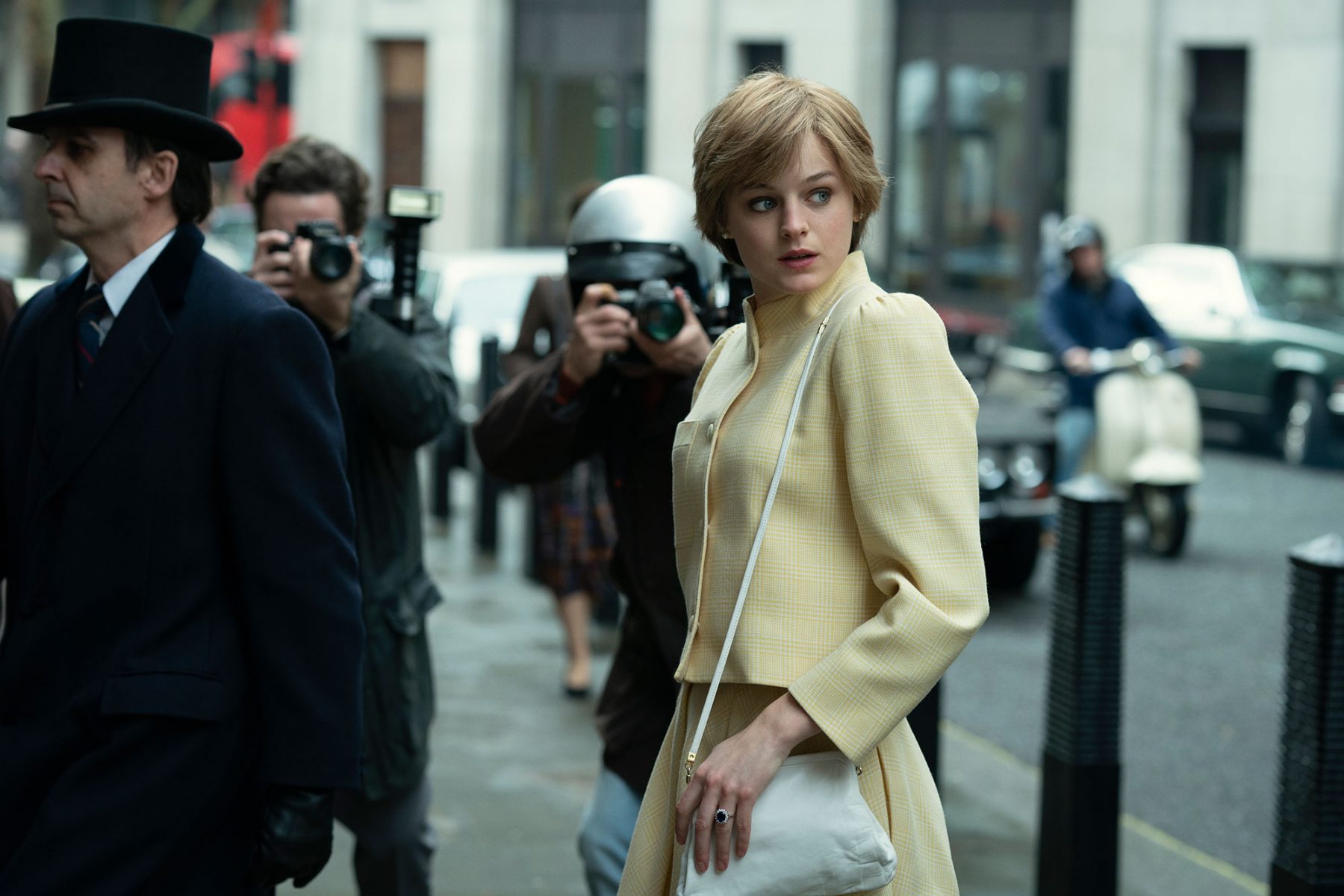When Netflix released the much-anticipated Season 4 of their award-winning show “The Crown” on Nov. 15, it quickly became the No. 1 show on the platform. “The Crown” is a historical drama, and in this new season, it depicts the lives of the British royal family in the 1980s. While the previous three seasons of “The Crown” focus heavily on the events surrounding Queen Elizabeth in a post-World War II United Kingdom, Season 4 includes details about the Queen’s first son and heir to the throne, Prince Charles, his wife Princess Diana and Prime Minister Margaret Thatcher.
One thing that attracted many fans to “The Crown” is the extreme attention to detail when it comes to the wardrobe and behaviors of the actors. The characters’ outfits are almost a replica of what their real-life counterparts wore to engagements and momentous events. The actors are also able to take on the posh British accent when speaking their lines. Emma Corrin, who plays Diana, imitates the princess’s voice by increasing her pitch at the beginning of her sentences and lowering it at the end.
Despite the royal family spending years trying to get good press for Camilla, the re-telling of her and Charles’ affair in the show revived pro-Diana sentiment from viewers all over the world. Many flocked to social media to express their love and appreciation for Diana and her efforts to modernize the monarchy and raise her children in the real world.
Although the events depicted in the show are entirely real, the dialogue between characters is purely the work of Peter Morgan, the award-winning writer of the show. It is also important to note that for this article, every time a royal’s name is mentioned, it is referring to the character in the show and not the actual person unless otherwise indicated.
The Crown Portrays the Power Dynamic Between Margaret Thatcher and Queen Elizabeth II
In the first episode, Margaret Thatcher (Gillian Anderson) comes into power as the U.K.’s first female prime minister. From the beginning, she establishes her goals for her term: cut public spending, increase the value of the pound and make the U.K. self-reliant. She immediately takes on her position with immense pride and firmly establishes herself as a figure of authority. Despite often being the only woman in the room, Anderson’s character does not allow other men to boss her around and tell her what she should be doing.
She continues to hold her ground while interacting with Queen Elizabeth (Olivia Coleman) in their recurring meetings. The two often disagree about how the country should be run, but Thatcher adamantly holds on to her conservative views and policies. In the fifth episode, when the two discuss the recent rise in unemployment, Thatcher says the government should not hold on to old ideas of collective duty and that “self-interested people who are trying to better themselves … That is the engine that fires the nation.”
The Queen holds her values dearly and often makes her opinions on government matters known privately to the prime minister. Her sense of duty is best summed up in the eighth episode when she says, “There are two families I care about. My own family and the Commonwealth family of nations. Keeping them all together is my life’s work.” In practice, neither she nor any other member of the royal family publicly expresses their opinion on political matters, and she rarely uses her constitutional powers. The Queen understands that she is not an elected official and should rule in a nonpartisan manner.
Prime Minister Thatcher and the Queen have a rift in Episode 8 when Thatcher refuses to join the Commonwealth countries and place sanctions on apartheid South Africa. Straying from her usual course of action, the Queen speaks out against her prime minister for the first time. Her actions cause a constitutional crisis in the U.K., which is swiftly cleaned up by her press office.
The Queen’s momentary lapse in judgment highlights an important theme that pervades the show: the difficulty of doing nothing. Many members of the family struggle with staying neutral during important events; however, they must do so to avoid losing their position in the state.
The strained relationship between Diana and Charles Is At The Core of Season 4
“The Crown” depicts Charles (Josh O’Connor) and Diana’s (Emma Corrin) marriage as a tale of extreme publicity, misplaced jealousy, extramarital affairs and worsening mental health with a few moments of joy. In the previous season, viewers could not help but pity Charles after his family prohibits him from marrying Camilla Shand (Emerald Fennell) due to fears of infidelity on her part. The royal family encourages Charles to marry Diana since she is young, pure and at the perfect age for childbearing. The two reportedly only met 16 times before their wedding ceremony.
The show highlights the many reasons why the marriage did not work out. As Princess Anne clearly states in the ninth episode, the two have a difficult time relating to one another because of their 12-year age gap and, “They come from similar aristocratic backgrounds but their personalities are from different planets.” While Charles is depicted as being more reserved, Diana is more outgoing and openly embraces the people she meets at events.
The forced marriage had enormous repercussions on the happiness and mental well-being of them both, which is depicted in the show. In almost every episode, Charles is seen either talking to Camilla over the phone or visiting her in person, desperately trying to find the companionship he lacks in his marriage. Diana starts out as a devoted wife who loves her husband, but as he continues to meet Camilla, she too finds comfort with other men. It is reported that she had affairs with her riding instructor, bodyguard and a military official.
Diana also developed bulimia as a side effect of her disastrous marriage. She is frequently seen throughout the show binge-eating to cope with how alone she felt, before throwing up in the bathroom. According to a real-life interview with the princess, her first bout with the eating disorder came after Charles put his hand on her waist and said, “Oh, a bit chubby here, aren’t we?”
The publicity Diana received from the public also created a wedge between them. Every time Corrin’s character is seen attending royal events, enormous crowds gather outside hoping to catch a glimpse of the princess and shouting: “We Love You Di!” After coming back from a successful solo trip to New York, Diana ends up fighting with her husband because of the good press she is getting. Camilla expresses to Charles how she would never live up to the name Diana created for herself and that the public would loathe her for breaking up their marriage.
The Royals Continue to Struggle for Relevance in a Modern and Post-World War II U.K.
One key aspect of “The Crown” is the British monarchy’s continued struggle to be relevant in the country’s modern society. In post-World War II U.K., many questioned the need for royalty, so the royal family had to adapt to the changing times. As the Queen, played by Claire Foy at the time, states, “The monarchy is too fragile. One more scandal, one more national embarrassment and it will all be over.”
However, Diana is seen as a beacon of hope for the family, offering them a chance to redeem their public image. In the sixth episode, Charles and Diana travel to Australia and New Zealand for their first official royal tour as a couple. New Zealand’s prime minister wants his country to break away from the grip of the English monarchy and stand on its own feet. Diana’s arrival ruins his plan. Despite a few mess-ups, Diana wins the hearts of Australians and New Zealanders with her kind spirit and relatability. In a radio interview, Diana comes across like another normal person and says, “I don’t think of myself as royalty. No. First and foremost, I’m a wife and a mother. That’s what’s most important to me.”
Her words strike a chord with many people and lead to her rise in popularity. In a meeting with the couple, New Zealand’s prime minister tells Charles, “That superstar may have just set back the cause of republicanism in Australia for the foreseeable future.”
“The Crown” does an excellent job of telling the story of the royal family during the 1980s. Everything from outfits and events to the behavior and body language of the royals is accurate captured. The scenic shots, coupled with the talented cast, leave viewers hungry for more episodes of this hit historical drama.
















